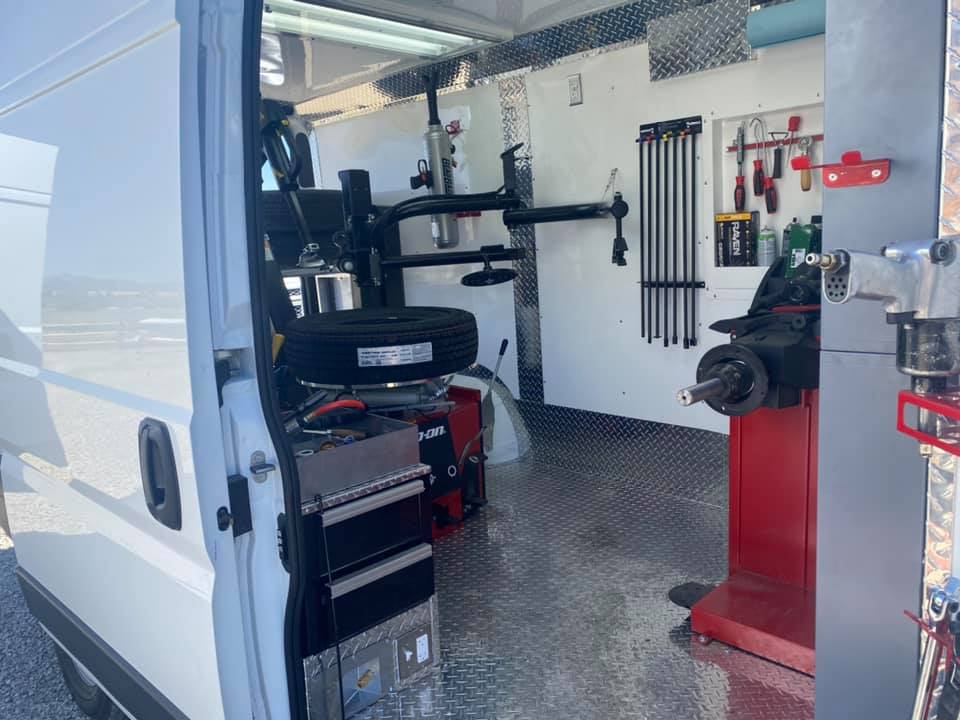Cost Effective Mobile Tire Replacement Las Vegas - Call Today!
Cost Effective Mobile Tire Replacement Las Vegas - Call Today!
Blog Article
Tire Service: Proven Techniques for Ideal Tire Maintenance and Treatment
Maintaining optimal tire problem is extremely important for both safety and performance of any kind of vehicle. From making sure appropriate tire pressure to routine rotation and alignment, there are proven methods that can substantially extend the lifespan of your tires and enhance total driving experience. As we discover the details of tire care and maintenance, we will certainly uncover vital guidelines that every lorry proprietor ought to follow for the ideal possible outcomes. Allow's explore the world of tire service and uncover the secrets to keeping your tires in excellent shape for the long haul.
Value of Tire Stress
Correct tire pressure is a critical consider ensuring ideal automobile efficiency and safety and security when driving. Maintaining the recommended tire pressure levels offered by the manufacturer supplies many benefits. First of all, adequate tire pressure advertises much better fuel effectiveness, as under-inflated tires can lead to raised rolling resistance, triggering the engine to function more difficult and eat more gas. Appropriate tire stress makes sure also walk wear, enhancing tire durability and conserving money in the lengthy run by delaying the need for premature substitutes. Furthermore, appropriately pumped up tires add to enhanced handling and braking capabilities, vital for safe driving in various roadway problems. Over-inflated tires, on the other hand, can cause minimized traction and a harsher experience. On the other hand, under-inflated tires are vulnerable to getting too hot, which can cause mishaps and blowouts. Frequently changing and checking tire pressure, particularly eventually journeys, is a basic yet effective means to enhance lorry performance, expand tire lifespan, and focus on safety when driving.
Tire Turning Standards
When thinking about tire rotation standards, it is important to comprehend the relevance of this maintenance job in making best use of tire life expectancy and preserving ideal car efficiency. Tire turning includes altering the placement of each tire on a car to guarantee also step wear. Front tires often tend to put on quicker than back tires because of guiding forces, making normal rotation vital for balanced wear patterns. The recommended rotation pattern differs relying on whether a car is front-wheel, rear-wheel, all-wheel, or four-wheel drive. Normally, tires should be turned every 5,000 to 7,500 miles, or as advised in the car guidebook. Disregarding tire rotation can result in unequal wear, affecting handling, grip, and possibly compromising vehicle security. By sticking to correct rotation guidelines, motorists can expand the life of their tires, improve gas performance, and boost total driving experience. Regular turning is an easy yet efficient upkeep practice that contributes substantially to tire long life and automobile efficiency.

Benefits of Wheel Positioning
Ensuring appropriate wheel placement after tire rotation is crucial for maintaining well balanced wear patterns and optimizing automobile efficiency. Furthermore, appropriate wheel positioning look at here assists to expand the life expectancy of your tires. Misaligned wheels can trigger unequal tire wear, leading to early tire replacement and raised maintenance prices.

Tire Tread Depth Check
Executing a normal evaluation of tire step depth is important for maintaining secure driving problems useful source and lengthening the life-span of your tires. The tread on your tires plays a crucial duty in supplying traction, particularly in unsafe or wet conditions. To examine your tire walk deepness, you can use a step depth scale or the penny examination. The recommended walk deepness goes to the very least 2/32 of an inch. It is time to replace your tires to ensure optimum performance and safety on the roadway if the walk depth is listed below this limit. Irregular tread wear can suggest problems with tire placement, stress, or suspension, highlighting the importance of regular step deepness checks. Overlooking to check and maintain appropriate tread deepness can lead to reduced grip, longer braking distances, and an increased threat of hydroplaning. By integrating tire tread depth explore your regular upkeep timetable, you can drive with self-confidence recognizing that your tires remain in top problem.
Seasonal Tire Evaluation
Seasonal tire assessment is a fundamental element of tire upkeep that makes sure tires are all set to deal with the obstacles presented by different climate conditions. In preparation for winter season, it is essential to inspect the tire stress on a regular basis see as chilly temperature levels can create tire stress to go down. By conducting routine seasonal tire evaluations, motorists can extend tire life-span, boost gas efficiency, and most importantly, guarantee a safe driving experience in varying weather conditions.
Final Thought
To conclude, maintaining proper tire stress, revolving tires on a regular basis, lining up wheels properly, keeping track of walk deepness, and performing seasonal assessments are necessary practices for optimum tire treatment. By following these proven methods, vehicle drivers can ensure their tires last much longer, do far better, and add to overall car safety and security. It is essential to focus on tire upkeep to avoid crashes, boost gas efficiency, and extend the life-span of tires.
Appropriate tire stress advertises much better fuel efficiency, as under-inflated tires can lead to boosted rolling resistance, triggering the engine to function harder and consume more fuel.When considering tire rotation guidelines, it is necessary to recognize the significance of this maintenance job in maximizing tire life expectancy and keeping optimum lorry performance. Seasonal tire assessment is a fundamental facet of tire upkeep that guarantees tires are ready to face the challenges postured by various climate conditions. By carrying out regular seasonal tire inspections, vehicle drivers can extend tire life expectancy, boost gas effectiveness, and most notably, guarantee a safe driving experience in varying climate conditions.
In verdict, preserving correct tire pressure, revolving tires consistently, lining up wheels appropriately, monitoring step deepness, and carrying out seasonal examinations are essential techniques for ideal tire care.
Report this page